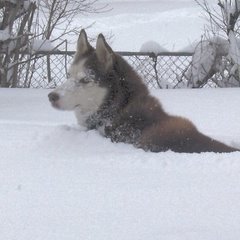Here's his latest one. I decided I should get some benefit from all that work! But he took a long time reformatting it for the blog. I thought it would take all the rest of the week!
Maybe you've already read it. (Like Mis Minky and her loyal subjects.) Don't worry! There will be a new post later!
Summer isn't here yet, but May is normally the month of Denver's first 90° weather of the year, and that means being careful about overheating animals with mushed-in faces.ⓣⓤⓒⓚⓔⓡ
As cute as brachycephaly is (and I had a beautiful blue Persian with copper eyes that, I'm pretty sure, was stolen), smushface breeds just can't handle the heat as well as animals with more normal snouts.
The classic breeds are Persians and Pugs:
Persian
Pug
But there are others, including Himalayans on the feline side, and Boston Terriers to Japanese Chins to Shar-Peis on the canine side. At the other end of the spectrum are dolichocephalic breeds such as Greyhounds and probably all of the sighthounds:
Borzoi
Pharoah Hound
Anyway, no long walks on hot days for the flat-faces. Here's the forecast:THE NATIONAL WEATHER SERVICE 30-DAY OUTLOOK MODEL INDICATES THAT DENVER WILL HAVE AT OR SLIGHTLY BELOW NORMAL PRECIPITATION DURING MAY 2008 AND THE MODELS INDICATE THAT DENVER WILL HAVE NEAR NORMAL TEMPERATURES.This seems consistent with predictions that we are coming out of a La Niña cycle (data on pages 26 - 30 of this pdf file) - which anyway seem to have less impact here in summer than in winter.
Now in case you were wondering how global warming will affect brachycephalic breeds....
(You were, weren't you? No? How about now? No? How about now?)
There's this story from Peter Munro at Australia's The Age:You thought penguins were in gravest danger of extinction from global warming.This is probably the most ignorant thing I've ever heard a vet say! In the first place, theories aren't able to act on their own. But what's more important is that most breeds of domestic animals exist because of human design, not natural selection.
Now bulldogs, boxers, Pekinese, pugs and French mastiffs are among the breeds of dogs that may not see out many more Australian summers, experts say.
Rising temperatures could also cast aside Persian cats in favour of fuller-faced felines.
Citing Charles Darwin's theory of evolution, RSPCA chief veterinarian Chris Thurgood said forecasts of frequent 40 degree [104° F] days would gradually deplete local stocks of short-nosed dogs and cats, which typically suffer from respiratory problems and heat stress.
"Darwin's theory will take care of them," he said. "They won't be around in the future; they won't last."
As long as humans want Persians and Pugs, there will be Persians and Pugs. Even in Australia! If heat-related deaths go up, I'm sure that breedings per year will go up, too. (Not that I'm saying that that's the right thing to do. I'm saying I think that's how humans will respond.)The director of Melbourne University's veterinary teaching hospital, Mark Davis, said dog owners should act responsibly by opting for long-nosed or long-tongued breeds such as greyhounds or golden retrievers. Dogs cool themselves by panting, which makes summer more difficult for breeds like bulldogs and pugs, which typically have squashed airways.Yes, let's all act responsibly, shall we? But could we start with chipping and neutering, please?Boxer Association of Victoria president Lionel Bleakley owns 14 boxers and three French mastiffs, which are also counted among the Brachycephalic dog breeds, with shortened or squashed faces.Tucker loves lying on the concrete. We'll see how Sinjin responds to our summer. (He's from Indianapolis ... compare our climate with theirs.) Sibes are out in storms at -60° to -70° F at the Iditarod (when suitably conditioned, of course).
"My dogs have been lying quite comfortably on the concrete," Mr Bleakley said.
"Dogs adapt and people adapt to how to raise dogs correctly, such as not walking their dogs on a hot day."
Well, anyway. For those who want to stay on top of all the changes global warming will bring about, I found a link to this story on a page with links to reports on a variety of topics from acne to yellow fever. Note the warning about dead links, and enjoy!
-- photos from Wikipedia





No comments:
Post a Comment